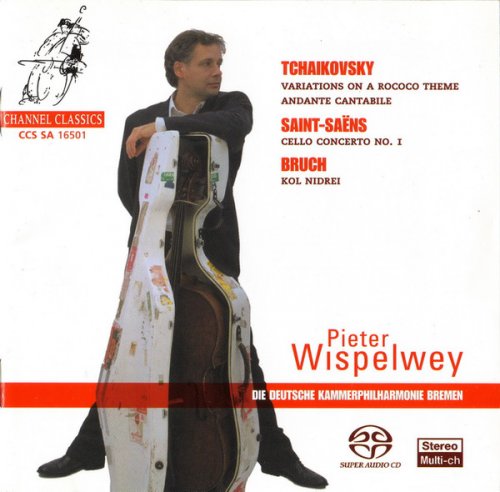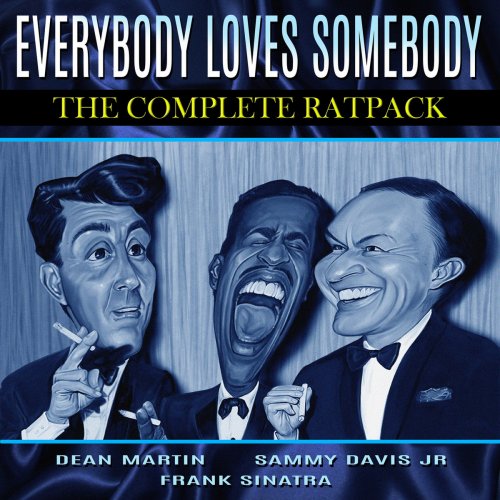Pieter Wispelwey - Tchaikovsky, Saint-Saens, Bruch (2001)

Artist: Pieter Wispelwey
Title: Tchaikovsky, Saint-Saens, Bruch
Year Of Release: 2001
Label: Channel Classics Records
Genre: Classical
Quality: APE (image + .cue, log, artwork)
Total Time: 55:16 min
Total Size: 217 MB
WebSite: Album Preview
Tracklist:Title: Tchaikovsky, Saint-Saens, Bruch
Year Of Release: 2001
Label: Channel Classics Records
Genre: Classical
Quality: APE (image + .cue, log, artwork)
Total Time: 55:16 min
Total Size: 217 MB
WebSite: Album Preview
Camille Saint-Saens (1835-1921)
Cello Concerto No 1 in A minor Op. 33 (1972)
01. Allegro non Troppo (5.24)
02. Allegretto con Moto (4.29)
03. Allegro non Troppo (8.31)
Pyotr Ilych Tchaikovsky (1840-1893)
04. Andante Cantabile Op. 11 (6.56)
Variations on a Rococo Theme Op. 33 (1886?)
05. Theme (2.34)
06. Variations 1 (0.53)
07. Variations 2 (1.16)
08. Variations 3 (3.41)
09. Variations 4 (1.56)
10. Variations 5 (3.32)
11. Variations 6 (2.31)
12. Variations 7 (2.11)
Max Bruch (1838-1920)
13. Kol Nidrеi Op. 47 (1881) (10.47)
This was the first commercially produced SACD hybrid super audio on the market. In June of 2000, I sat in one room recording in pcm and the research team of Philips were in the room next door taking my analogue signal directly from my mixer. I first released my pcm version in the fall of 2000. The Pyramix at that time was very primitive but thanks to the Phliips team who worked around the clock to produce the software, we were able to get this DSD version out at the beginning of 2001.
Jared Sacks
SAINT-SAENS TCHAIKOVSKY BRUCH I still find it striking that when we are asked for a typically romantic cello concerto, we think immediately of Dvorok, or even of Elgar, even though these works were composed respectively in 1895 and 1919, while the truly romantic cello concerti are actually those by Schumann (1850), Saint-Saitns (1870), and Tchaikovsky (1876). It would appear, then, that there are considerable misapprehensions about the nature of romanticism and the 19th century. In any case, the latter three works do not present the cello as a primarily autumnal and nostalgic instrument Singing yes, expressive, yes, but also agile and flexible. Moreover, the soft spot that I have for these pieces lies in the intriguing counterpoint of passion and ironic elegance, enthusiasm and civilization, a style in which, on one hand, aristocracy and on the other, sensuality and passion, play into each other’s hands. Under the surface, feelings of fear, regret, protest and impossible longing play their roles, but the balance between intoxication and discipline predominates. A simple example of that balance can be seen in the opening 8 measures of the famous theme from Tchaikovsky’s Rococo Variations. A sort of formal decorum alternates every 2 measures with emotionalism, the other supporting pillar of the composition. The symbiosis in a nutshell. A good example of the deceptiveness of outward appearances is the close of the central movement of the Saint-Saltns. Unexpectedly, diverse elements from the minuet theme take on new and ultimately dark and foreboding forms, and suddenly we are engulfed in psychological quicksand. Quickly the wrinkles are ironed out again, but that moment of magic will remain in the listener’s unconscious. We hope that you will excuse us for adding two unmistakably late-romantic works to SaintSans and the ‘Rococo and invite you to see the combination of styles in the context of counterpoint and polemic contrast Moreover, a bit of cellistic nostalgia never hurts. Pieter Wispelwey
Jared Sacks
SAINT-SAENS TCHAIKOVSKY BRUCH I still find it striking that when we are asked for a typically romantic cello concerto, we think immediately of Dvorok, or even of Elgar, even though these works were composed respectively in 1895 and 1919, while the truly romantic cello concerti are actually those by Schumann (1850), Saint-Saitns (1870), and Tchaikovsky (1876). It would appear, then, that there are considerable misapprehensions about the nature of romanticism and the 19th century. In any case, the latter three works do not present the cello as a primarily autumnal and nostalgic instrument Singing yes, expressive, yes, but also agile and flexible. Moreover, the soft spot that I have for these pieces lies in the intriguing counterpoint of passion and ironic elegance, enthusiasm and civilization, a style in which, on one hand, aristocracy and on the other, sensuality and passion, play into each other’s hands. Under the surface, feelings of fear, regret, protest and impossible longing play their roles, but the balance between intoxication and discipline predominates. A simple example of that balance can be seen in the opening 8 measures of the famous theme from Tchaikovsky’s Rococo Variations. A sort of formal decorum alternates every 2 measures with emotionalism, the other supporting pillar of the composition. The symbiosis in a nutshell. A good example of the deceptiveness of outward appearances is the close of the central movement of the Saint-Saltns. Unexpectedly, diverse elements from the minuet theme take on new and ultimately dark and foreboding forms, and suddenly we are engulfed in psychological quicksand. Quickly the wrinkles are ironed out again, but that moment of magic will remain in the listener’s unconscious. We hope that you will excuse us for adding two unmistakably late-romantic works to SaintSans and the ‘Rococo and invite you to see the combination of styles in the context of counterpoint and polemic contrast Moreover, a bit of cellistic nostalgia never hurts. Pieter Wispelwey
Related Release:



![Mark Pringle - New Customers (2025) [Hi-Res] Mark Pringle - New Customers (2025) [Hi-Res]](https://www.dibpic.com/uploads/posts/2025-12/1765497171_fb7vtyplm5lta_600.jpg)



![Marju Kuut - Marju Kuut: Üksi, kuid vabana (2025) [Hi-Res] Marju Kuut - Marju Kuut: Üksi, kuid vabana (2025) [Hi-Res]](https://www.dibpic.com/uploads/posts/2025-12/1765641100_cover.jpg)
